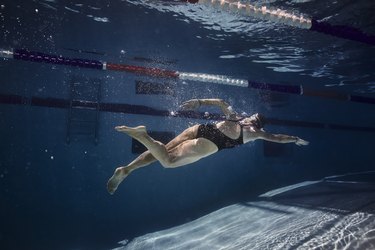
Swimming after giving birth helps you lose weight and restore muscle tone. It also boosts your strength and energy, which may be sapped after your pregnancy and delivery.
Swimming is particularly beneficial because it works your upper and lower body and your core. Plus, it's low-impact and reduces the stress on your weight-bearing joints, which become looser during pregnancy. Consult your doctor first and follow a few guidelines to start swimming safely postpartum.
Video of the Day
Video of the Day
When to Start Swimming Postpartum
Some women can start exercises such as walking at a mild to moderate pace within a few days of childbirth. However, it's best to wait until your lochia — the vaginal discharge after childbirth — ceases before starting to swim.
Lochia usually begins to taper off seven to 10 days after childbirth, but won't stop completely for another two to four weeks, according to Johns Hopkins Medicine. Also, if you've had an episiotomy, you should wait until it's well-healed, usually after four weeks, before starting to swim. Returning too soon can lead to possible infection.
After a cesarean section, in general, you can start going to the gym or resuming a full workout within six to eight weeks . Unless your wound is not healing properly or is infected, there's no reason why you shouldn't be able to start swimming once the lochia ceases.
However, the American College of Obstetricians and Gynecologists advises asking your doctor when it is safe to begin exercising after a cesarean. Even with her approval, you may want to wait until you no longer have any cramping or pain in your incision.
Read more: 7 Tips to Become a Better Swimmer
Weight Loss From Postpartum Swimming
Swimming postpartum can also help you lose any excess weight from your pregnancy. Once you begin swimming after giving birth, work your way up to 30 minutes to one hour daily. Swimming for 30 minutes burns about 223 calories for a 155-pound person, according to Harvard Health Publishing.
You can also drop extra pounds if you cut calories from your diet. To lose a pound, you'll need to take in 3,500 fewer calories than you burn — which you can accomplish by eating less and exercising more.
Avoid obsessing too much over calories, especially if you're breastfeeding. Your baby needs the extra nutrients that a proper diet provides. According to the Mayo Clinic, you might need an extra 330 to 400 calories a day while breastfeeding. Opt for lean proteins, whole grains, fruits and vegetables to ensure proper nutrition for you and your baby.
Stay Safe in the Water
Monitor your health after giving birth to determine if you're ready to start any swimming after giving birth, or any exercise for that matter. Pace yourself — there's no rush.
Watch for symptoms that signal trouble, such as bleeding or increasing pain. If you do have these symptoms after swimming, consult your doctor.
Also, drink water before, during and after your swimming session to prevent dehydration. Avoid swimming alone; you may be exhausted and quick to tire as a new mother.. It's best to have a friend or family member nearby in case you need help.
When your baby is old enough, you can begin introducing swim safety habits to your child, too. The American Academy of Pediatrics suggests starting your child with water survival skills training around age 1. You may choose to join a parent-baby class initially, then gradually have your child move on to independent lessons around age 4.
- Johns Hopkins Medicine: "Postpartum Discharge Instructions"
- American College of Obstetricians and Gynecologists: "Exercise After Pregnancy"
- Harvard Health Publishing: "Calories Burned in 30 Minutes for People of Three Different Weights"
- Mayo Clinic: "Breast-Feeding Nutrition: Tips for Moms"
- American Academy of Pediatrics: "Swim Lessons: When to Start & What Parents Should Know"
- BabyCenter: Postpartum - Normal Bleeding and Discharge (Lochia)